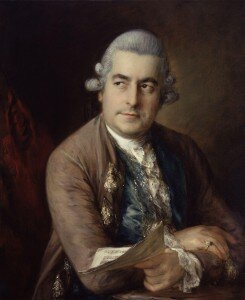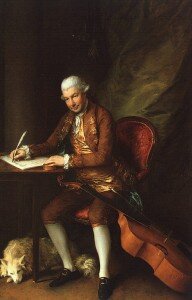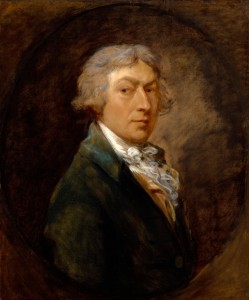
Gainsborough: Carl Friedrich Abel (1765)
Johann Christian Bach (1735-1782) was the youngest of J.S. Bach’s eleven sons and made his career in London, where he was called the “English Bach.” Born when his father was 50 years old, he lived with his older half-brother C.P.E. Bach after his father’s death in 1750 when he was just 15.
Life with C.P.E. Bach put him in a household with a leading composer at its head. C.P.E. was considered to be the most talented composer of the Bach children, working in the transition between the Baroque style of his father and the upcoming Classical and Romantic styles. Under C.P.E.’s guidance, J.C.’s keyboard skills and composition skills improved to the point where he became both a composer and a performer. He toured with the viola da gambist and composer Carl Friedrich Abel, and they gave concerts through Germany. Abel had been a student of J.S. Bach’s at the St. Thomas School in Leipzig.
Abel: 27 Pieces for Viola da Gamba, WKO 186-212: I. Allegro, WK 186 (Petr Wagner, viola da gamba)

Gainsborough: Self-portrait (ca. 1739)
(private collection, UK)
Living in Italy from 1754, J.C. secured an appointment as second organist at Milan Cathedral and started to compose serious operas for the courts in Turin and Naples. Finally, in 1762, he was invited to compose operas for the King’s Theatre in London. His first opera in London was Orione, which opened in 1763.
The success of Orione led to his appointment of music master to Queen Charlotte. In 1764, he met up with C.F. Abel again and they set up a house together where they held concerts. Abel also got an appointment with the Queen. In 1764, when the young Mozart made his second appearance in London at the court, he played music by the leading composers of London: J.C. Bach, Abel, and Handel.

Gainsborough: Johann Christian Bach (1776)
(National Portrait Gallery, London)
In 1765, Gainsborough depicted the young Abel, at three-quarter’s length, bow at the ready, listening to something out of view to the right. Has he just stopped playing or is he about to play? Abel’s hand gripping the bow is correct, because he had been teaching Gainsborough how to play the instrument. On the table to his side is music paper and pen at the ready, showing his other profession as composer. He’s dressed sumptuously – his red coat with gold buttons, a gold waistcoat with more gold buttons, and lace at his wrists and throat. Gainsborough repaid him in art and visitors to Abel’s studio said that his walls were covered in Gainsborough’s paintings and drawings, pinned to the wallpaper.
The English painter Thomas Gainsborough (1727-1788) was one of the most important British portrait artists in the second half of the 18th century. Even in his self-portrait, we see in the 13-year-old Gainsborough the same assurance we see in his portraits over the next 50 years.

Gainsborough: Carl Friedrich Abel (1777)
He was admired for his portraits but he was more fond of his landscapes. When he set up business in London he quickly ran into Bach and Abel. They were behind the plans for a new concert hall on Hanover Square and Gainsborough added in his skills for the decorations. The new concert hall opened in 1775 and both Bach and Abel served as concertmaster for its orchestra. Unfortunately, the hall failed, largely due to the competition for concerts in London, leaving Bach in debt.
In 1776, J.C. sat for Gainsborough, and he was portrayed in a half-length figure with music in his left hand. On his right hand, a ring is exhibited. The music can’t be identified, but that’s not uncommon. The composer is shown in a listening mood, his head cocked to the side and his eyes focused on something in the side distance. His wig is perfectly set and he presents a sympathetic image. One critic noted that this picture was one that could only have been done by a close friend.

Gainsborough: Self-portrait (1787)
(Royal Academy of Arts, London)
Of note are his clothes: his coat is decorated with golden tassels and his left arm also is decorated. His waistcoat is also decorated in gold; he has lace at his throat and his wrists. This wouldn’t be a regular outfit, but more probably a costume for a performance.
The next portrait Gainsborough painted was of Abel, shown as both an active composer and performer, his gamba laid across his knee. The 11-years between the pictures shows us an experienced composer, dressed even more luxuriously, with gold tassels now instead of gold buttons. The round snuffbox shown on the table is now gold – in the early image it was wooden. The dog at Abel’s feet shows up in other Gainsborough paintings and is thought to be one of the many that the painter had.
Both of the 1770 portraits show our musicians at the height of their powers. By 1781, the Bach-Abel concerts were coming to an end and Bach was facing health and financial problems. J.C. Bach died 1 January 1782 and for Abel, he faced the end of a 40-year friendship. He left London to avoid his debts and regain his fortune. He returned to London in 1784, restarted his concert series, but interest in his music was waning. He gave fewer concerts, and died in 1787, following a period of serious illness. Gainsborough died in 1788, and his final self-portrait was one he had been painting for Abel, but Abel died before seeing it.

Thank you for these interesting articles.